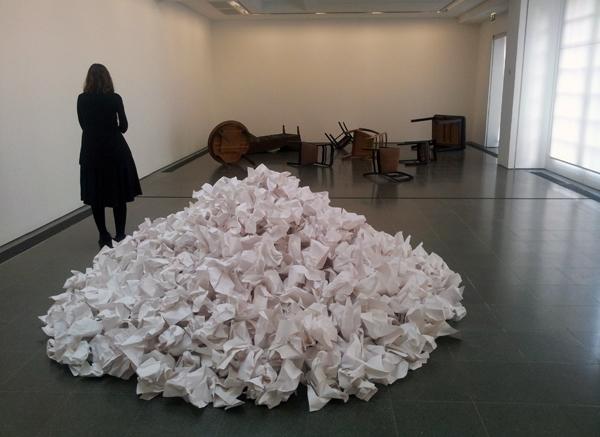The Serpentine Galleries present two exhibitions this winter, with Julio Le Parc at the Serpentine Sackler Gallery – and an exhibition of the sculpture and installation of Reiner Ruthenbeck. This is the first major survey in the UK of German sculptor and conceptual artist Ruthenbeck at the older Serpentine Gallery; the artist manipulates the geometry of form, creating spatially transformative works using unconventional materials such as crumpled paper or swathes of fabric. Ruthenbeck often subverts the familiar, using minimalist objects and simple everyday materials to explore architecture, iconology, perception, and in later works, sound. The exhibition brings together, for the first time in the UK, many of these key moments in the artist’s career and will include sculpture, objects and conceptual works.
An aspect to this exhibition is currently making headlines; Ruthenbeck’s installation of a room full of overturned furniture has drawn attacks of a verbal nature from the public. The installation at the far end of a wing of the Serpentine, was created in 1971 by the German sculptor – and has been compared to a “study (the ‘reading’ kind one would assume, not the artistic) ready to be tidied up”. But countering the usual cries of derision; the piece is actually a highly traditional piece of installation art.
In fact Ruthenbeck studied under the now acclaimed if still misunderstood German great: Joseph Beuys. The artist was taking photographs of the Fluxus concerts at the Art Academy Düsseldorf, before becoming a student of Beuys. Ruthenbeck enrolled as a member of Beuys’ sculpting class from 1962 to 1968. To begin with the artist continued in the field of photography, yet his artistic interests increasingly shifted towards sculptural concerns and the language of minimalist, reduced objects. On completing his apprenticeship with Beuys, Ruthenbeck became a sculptor. The artist’s sculptures and objects were first exhibited in 1968, at the Gallery Konrad Fischer in Düsseldorf.
Ruthenbeck is also a contemporary of Gerhard Richter and Sigmar Polke, and was with them in Düsseldorf in the Sixties, when the industrial German city became a European centre of experimental art. The artist is concerned with a principle that he acquired from Beuys; this is an artist interested in the language of sculpture. But not in quite the same poetic, esoteric, or shamanistic ways as his mentor. Although the substance of material shares a similar importance to the use of say, fat, or felt with Beuys. Ruthenbeck is more concerned with a purity of language. The artist’s concerns connect his works to the conceptualisation of objects in Minimalist Art and Arte Povera.
Ruthenbeck’s chairs were an experiment. The work ‘Umgekppte Möbel 1971/1993 (Overturned Furniture) were tipped over one at a time, the artist then added to the work until he felt it was complete. A theme running through many of artist’s works is experimentation with the gravity or the structure of simple furniture objects and items of practical use. Ruthenbeck subverts meaning through the semi-Duchampian act of removing the practical purpose of the objects; in removing functionality the artist changes the meaning of the form through a particularly pure aspect of sculptural language. Ruthenbeck merely changes the position of the furniture – a functional object designed around the human body – the ‘identity’ of the object is denied; tipped over, it is no longer of practical use – the furniture becomes a sculptural object. The artist then added to the number of these ‘objects’ forming spatial relationships between the forms.
Continuing with Ruthenbeck’s interest in spatial polarities, the works ‘Plattenbogen’ (Book Plate) 100/3/SR 1991 is comprised of a black square painted onto an aluminium panel which bends away from the wall. This again punctuates the space and exemplifies the artist’s spatial concerns. With the work Ruthenbeck straddles the formal divide between painting and sculpture as the work peels its 2-dimensional self from the wall and in doing so becomes an object. The particular hue of black on the surface of the work is reminiscent of ‘Kapoorian’ pigments manipulating the viewers perception of depth.
With the work ‘Koffer’ (1968); a suitcase accompanied by a soundtrack from Danish artist and composer Henning Christiansen, the artist again subverts the object and space simultaneously, as the echoing music emanates from a perfectly circular black hole in the suitcase; the object is at once more playful than Ruchenbeck’s surrounding works, with a surrealist leaning – yet for all of the amusement the piece has a genuine concern with the space of both the interior of the object, and that of the gallery – as sound pervades and resonates through the exhibition.
The artist likes to subvert, but it is hardly shocking to overturn furniture – if it ever was – the use of the ready-made in art has a very long history indeed; this is a particular language that has been used sufficiently enough that the viewer should – after a hundred years of it seeping into contemporary art, and western cultural perception – understand the vocabulary of one of Düsseldorf’s sculptural purists, who is certainly not ready to be tidied up any time soon.
Read the review of Julio Le Parc at the Serpentine Sackler Gallery here
Reiner Ruthenbeck, The Serpentine Gallery – Julio Le Parc Serpentine Sackler Gallery – until 15 February 2015
Words: Paul Black Photo: P A Black © Artlyst 2014 photo Artlyst all rights reserved

